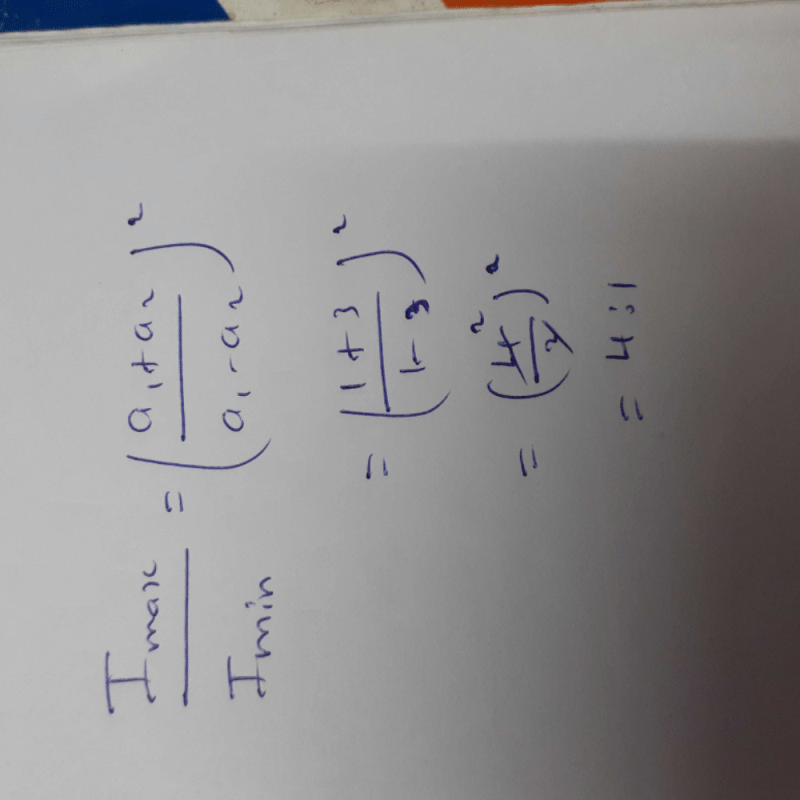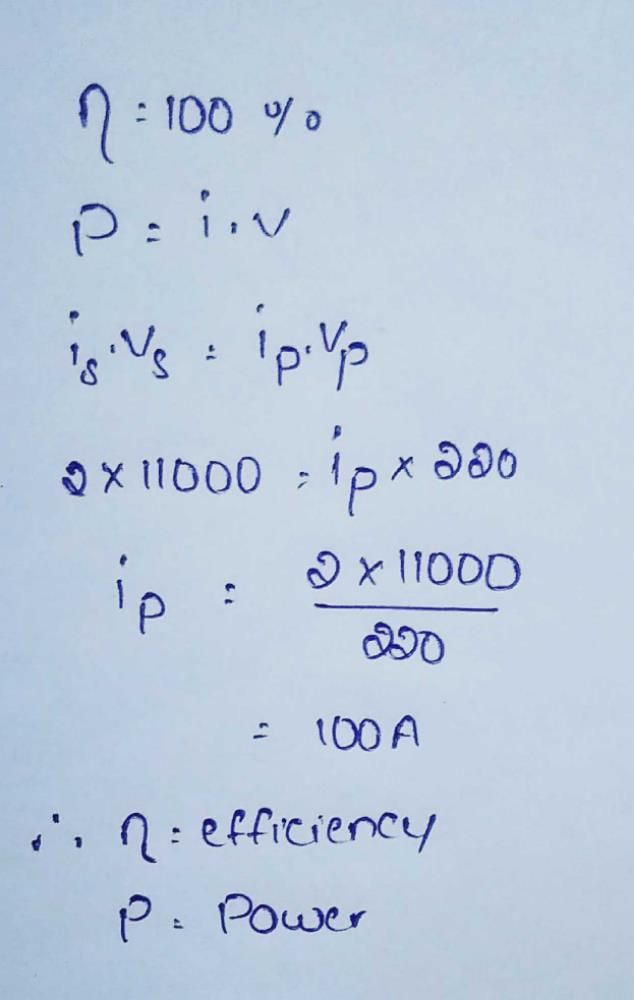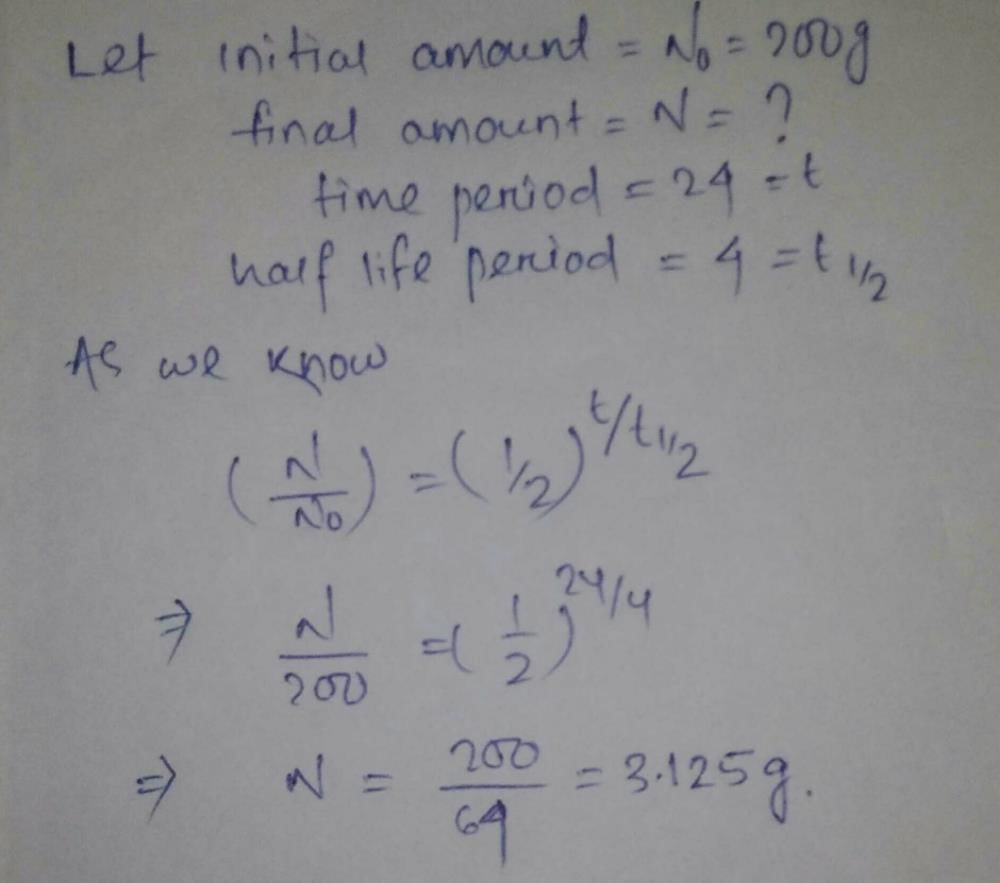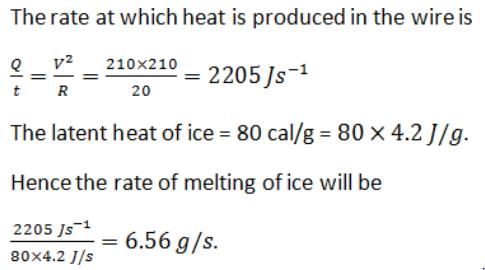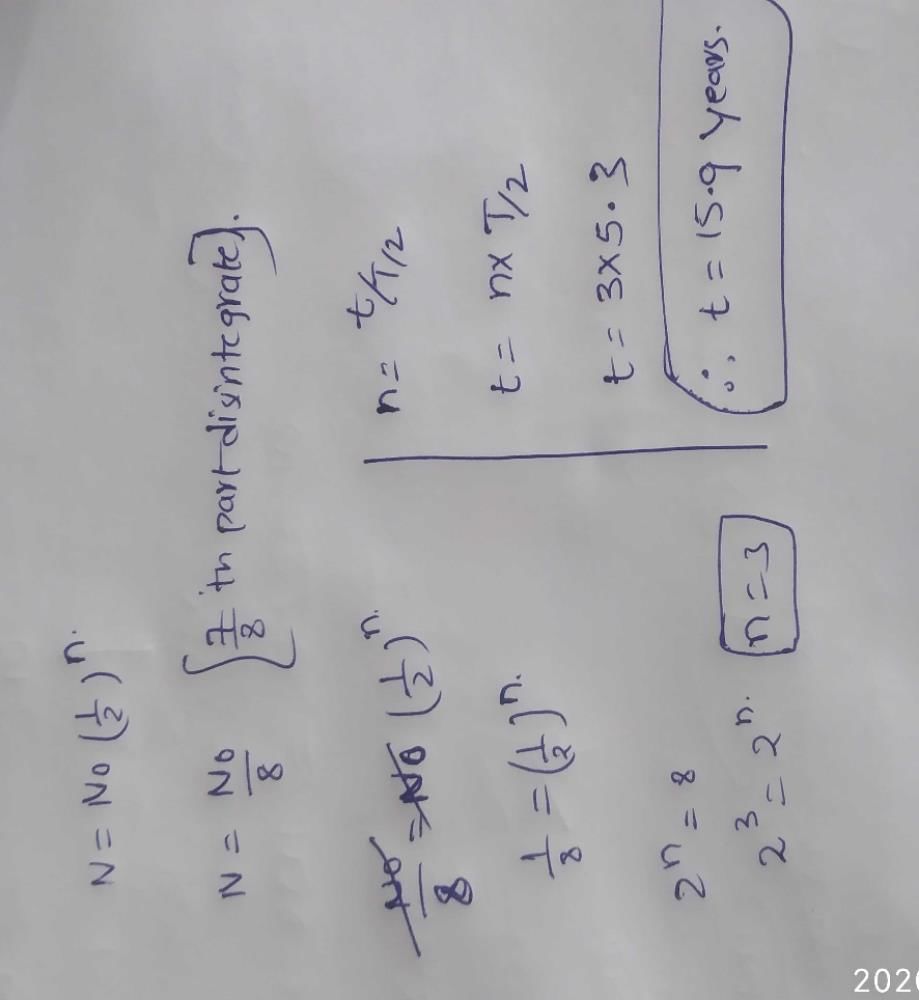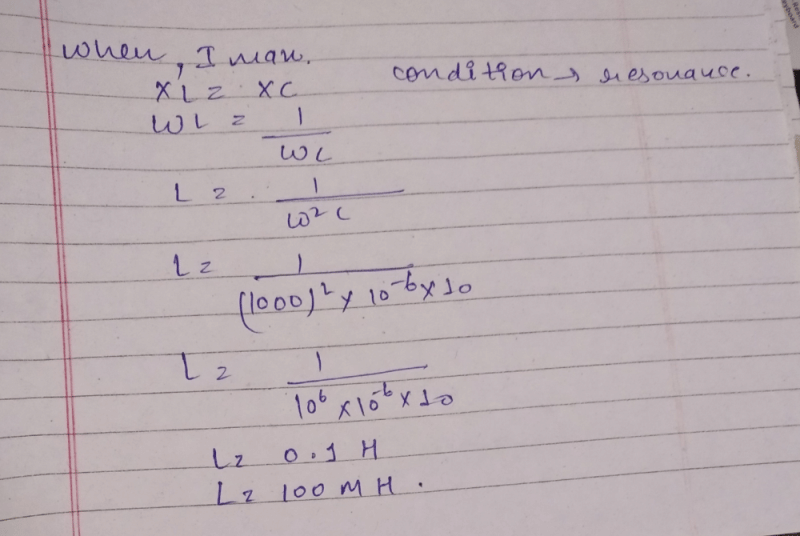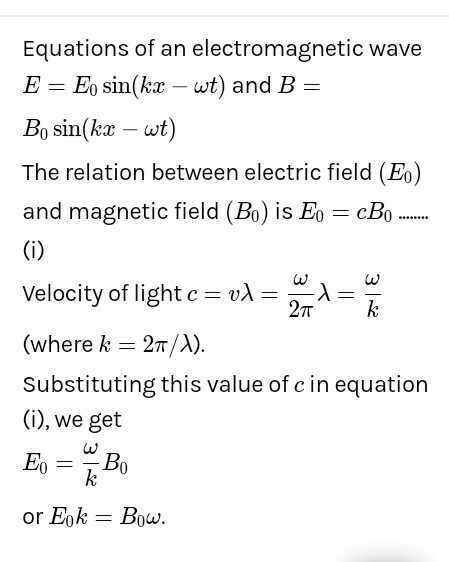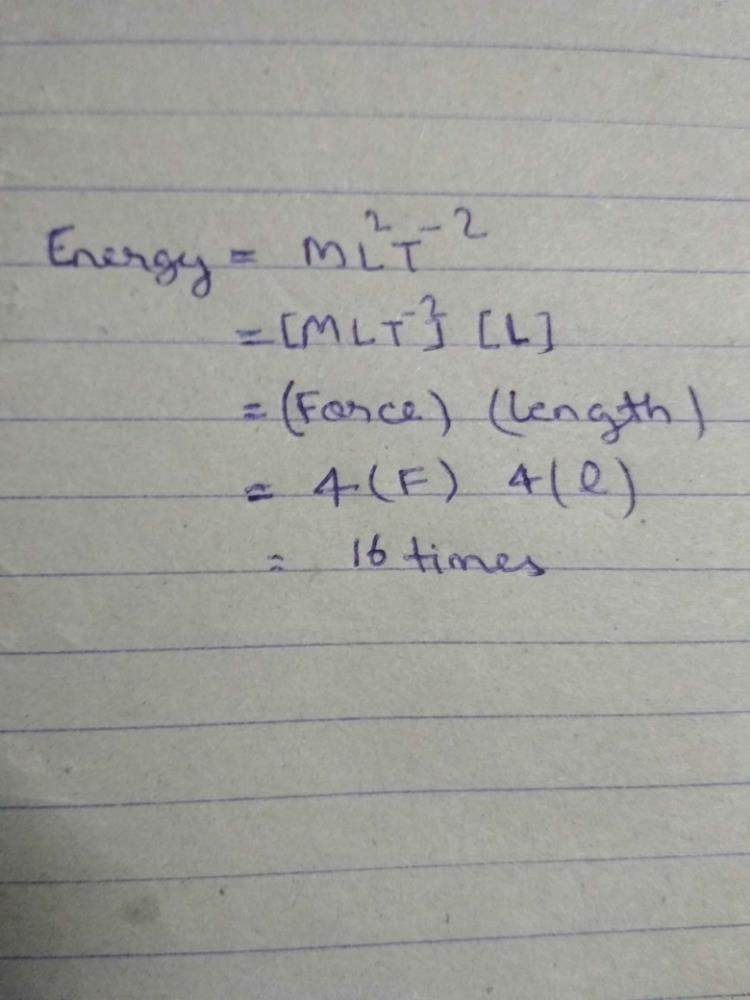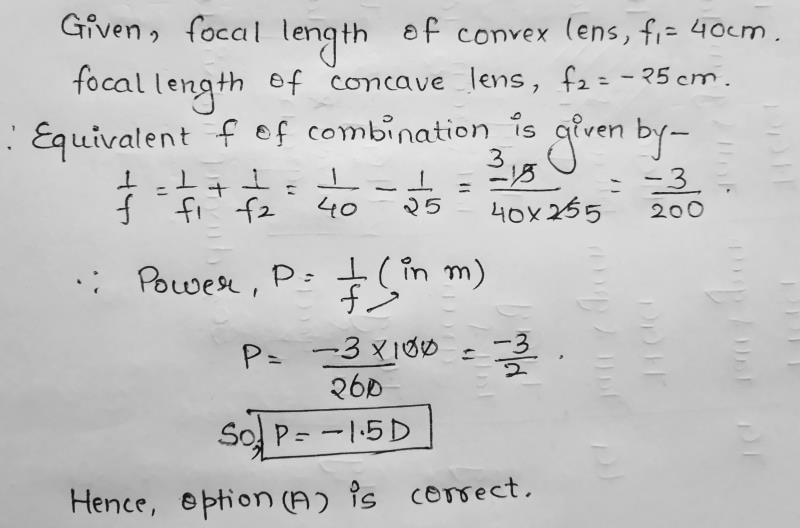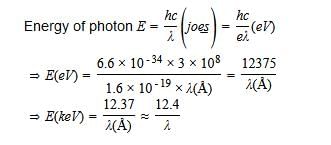All Exams >
NEET >
AIIMS Mock Tests & Previous Year Question Papers >
All Questions
All questions of AIIMS Physics Mock Tests for NEET Exam
A bomb of mass 9 kg explodes into two pieces of masses 3kg and 6kg. The velocity of 3kg mass is 16m/s . The K.E of 6kg mass is- a)238J
- b)96 J
- c)10.125J
- d)192 J
Correct answer is option 'D'. Can you explain this answer?
A bomb of mass 9 kg explodes into two pieces of masses 3kg and 6kg. The velocity of 3kg mass is 16m/s . The K.E of 6kg mass is
a)
238J
b)
96 J
c)
10.125J
d)
192 J
|
|
Ujwal Kumar answered |
Given:
Mass of bomb, m = 9 kg
Mass of first piece, m1 = 3 kg
Velocity of first piece, v1 = 16 m/s
We need to find the kinetic energy of the second piece, m2 = 6 kg
Solution:
1. Conservation of momentum:
Before the explosion, the bomb was at rest, so the initial momentum was zero.
After the explosion, the momentum of the first piece (m1) is:
p1 = m1 * v1 = 3 kg * 16 m/s = 48 kg m/s
The momentum of the second piece (m2) is:
p2 = m * v2
where v2 is the velocity of the second piece.
By conservation of momentum, we have:
p1 + p2 = 0
48 + m * v2 = 0
v2 = -48/m
v2 = -48/6 = -8 m/s
2. Kinetic energy:
The kinetic energy of a body of mass m and velocity v is given by:
K.E = (1/2) * m * v^2
For the second piece (m2), we have:
K.E = (1/2) * 6 kg * (-8 m/s)^2
K.E = 192 J
Therefore, the kinetic energy of the second piece is 192 J, which is option D.
Mass of bomb, m = 9 kg
Mass of first piece, m1 = 3 kg
Velocity of first piece, v1 = 16 m/s
We need to find the kinetic energy of the second piece, m2 = 6 kg
Solution:
1. Conservation of momentum:
Before the explosion, the bomb was at rest, so the initial momentum was zero.
After the explosion, the momentum of the first piece (m1) is:
p1 = m1 * v1 = 3 kg * 16 m/s = 48 kg m/s
The momentum of the second piece (m2) is:
p2 = m * v2
where v2 is the velocity of the second piece.
By conservation of momentum, we have:
p1 + p2 = 0
48 + m * v2 = 0
v2 = -48/m
v2 = -48/6 = -8 m/s
2. Kinetic energy:
The kinetic energy of a body of mass m and velocity v is given by:
K.E = (1/2) * m * v^2
For the second piece (m2), we have:
K.E = (1/2) * 6 kg * (-8 m/s)^2
K.E = 192 J
Therefore, the kinetic energy of the second piece is 192 J, which is option D.
Can you explain the answer of this question below:The value of the current through an inductance of 1 H and of negligible resistance, when connected through an A.C. source of 200 V and 50 Hz, is
- A:
0.637 A
- B:
1.637 A
- C:
2.637 A
- D:
3.637 A
The answer is a.
The value of the current through an inductance of 1 H and of negligible resistance, when connected through an A.C. source of 200 V and 50 Hz, is
0.637 A
1.637 A
2.637 A
3.637 A
|
|
Rajat Kapoor answered |
I = V/XL = 200/ωL = 200/2π x 50 x 1 = 0.637A
The penetrating power of X - rays increases with the- a) Increase in its velocity
- b) Decreases in its velocity
- c) Decrease in its frequency
- d) Increase in its frequency
Correct answer is option 'D'. Can you explain this answer?
a)
Increase in its velocity
b)
Decreases in its velocity
c)
Decrease in its frequency
d)
Increase in its frequency
|
|
Rajat Kapoor answered |
Penetrating power of X-rays depends upon the speed of electrons. The speed acquired by electrons can be increased, by increasing the potential difference between filament and anode.
Which of the followings are favourable conditions for physical adsorption:- a)High P
- b)Higher Tc
- c)High temperature
- d)Decrease in heat enthalp y
Correct answer is option 'A,B,D'. Can you explain this answer?
Which of the followings are favourable conditions for physical adsorption:
a)
High P
b)
Higher Tc
c)
High temperature
d)
Decrease in heat enthalp y

|
Rajeev Sharma answered |
Physical adsorption is weak and decreases with rise in temperature.
Physical adsorption is favoured at low temperature.
Physical adsorption is favoured at low temperature.
How much force is required to produce an elongation of 0.2% in the length of a brass wire of diameter 0.6 mm? (Take Young's modulus for brass = 0.9x1011 N-m⁻2)- a)17 N
- b)34 N
- c)51 N
- d)68 N
Correct answer is option 'C'. Can you explain this answer?
How much force is required to produce an elongation of 0.2% in the length of a brass wire of diameter 0.6 mm? (Take Young's modulus for brass = 0.9x1011 N-m⁻2)
a)
17 N
b)
34 N
c)
51 N
d)
68 N
|
|
Nitya Bose answered |
Given:
Diameter of brass wire, d = 0.6 mm
Elongation in length, ΔL/L = 0.2% = 0.002
Young's modulus for brass, Y = 0.9x10^11 N/m^2
To Find: The force required to produce the elongation
Solution:
We know that Young's modulus can be defined as the ratio of stress to strain i.e., Y = (F/A)/(ΔL/L), where F is the force applied, A is the area of cross-section of the wire and ΔL/L is the strain.
- Calculation of area of cross-section:
The diameter of the wire, d = 0.6 mm
Radius, r = d/2 = 0.3 mm = 0.3 x 10^-3 m
Area of cross-section, A = πr^2 = π(0.3 x 10^-3)^2 = 7.07 x 10^-7 m^2
- Calculation of force required:
We are given, ΔL/L = 0.002
Using the formula of Young's modulus, Y = (F/A)/(ΔL/L)
F = A Y ΔL/L = (7.07 x 10^-7) x (0.9 x 10^11) x 0.002 = 1.27 x 10^5 N
Therefore, the force required to produce the elongation of 0.2% in the length of the brass wire of diameter 0.6 mm is 51 N (approx).
Hence, option (c) is the correct answer.
Diameter of brass wire, d = 0.6 mm
Elongation in length, ΔL/L = 0.2% = 0.002
Young's modulus for brass, Y = 0.9x10^11 N/m^2
To Find: The force required to produce the elongation
Solution:
We know that Young's modulus can be defined as the ratio of stress to strain i.e., Y = (F/A)/(ΔL/L), where F is the force applied, A is the area of cross-section of the wire and ΔL/L is the strain.
- Calculation of area of cross-section:
The diameter of the wire, d = 0.6 mm
Radius, r = d/2 = 0.3 mm = 0.3 x 10^-3 m
Area of cross-section, A = πr^2 = π(0.3 x 10^-3)^2 = 7.07 x 10^-7 m^2
- Calculation of force required:
We are given, ΔL/L = 0.002
Using the formula of Young's modulus, Y = (F/A)/(ΔL/L)
F = A Y ΔL/L = (7.07 x 10^-7) x (0.9 x 10^11) x 0.002 = 1.27 x 10^5 N
Therefore, the force required to produce the elongation of 0.2% in the length of the brass wire of diameter 0.6 mm is 51 N (approx).
Hence, option (c) is the correct answer.
A 10 μ F capacitor and a 20 μ F capacitor are connected in series across 200 V supply line. The charged capacitors are then disconnected from the line and reconnected with their positive plates together and negative plates together and no external voltage is applied. What is the potential difference across each capacitor?- a)800/9 volt
- b)800/3 volt
- c)400 volt
- d)200 volt
Correct answer is 'A'. Can you explain this answer?
A 10 μ F capacitor and a 20 μ F capacitor are connected in series across 200 V supply line. The charged capacitors are then disconnected from the line and reconnected with their positive plates together and negative plates together and no external voltage is applied. What is the potential difference across each capacitor?
a)
800/9 volt
b)
800/3 volt
c)
400 volt
d)
200 volt
|
|
Riya Banerjee answered |
Initially potential difference a cross each capacitor
V1 = 20 / ( 10 + 20 ) x 200 = 400 / 3. V
V2 = 10 / (10 + 20) x 200 = 200 / 3. V
Finally, Common potential V = C1V1 +C2V2 / C1 + C2
V= 10 X 400/3 + 20 X 200/3 / ( 10 + 20 )
V = 800 / 9 . V
Two waves of same frequency, but of amplitudes in the ratio 1:3 are superimposed. The ratio of maximum to minimum intensity is- a)4 : 1
- b)1 : 4
- c)3 : 1
- d)1 : 3
Correct answer is option 'A'. Can you explain this answer?
Two waves of same frequency, but of amplitudes in the ratio 1:3 are superimposed. The ratio of maximum to minimum intensity is
a)
4 : 1
b)
1 : 4
c)
3 : 1
d)
1 : 3
|
|
Ram Mohith answered |
Intensity is directly proportional to the square of resultant amplitude at a point. Also, maximum intensity is when the amplitudes add up (constructive interference) and minimum interference is when the amplitudes subtract each other (destructive interference).
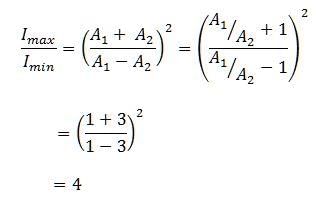

If the current is halved in a coil, then the energy stored is how much times the previous value
- a)1/2
- b)1/4
- c)2
- d)4
Correct answer is option 'B'. Can you explain this answer?
If the current is halved in a coil, then the energy stored is how much times the previous value
a)
1/2
b)
1/4
c)
2
d)
4
|
|
Isha Khanna answered |
To understand why the correct answer is option 'B', let's consider the concept of energy stored in a coil.
The energy stored in a coil, also known as the magnetic field energy, is given by the equation:
E = (1/2) * L * I^2
where E is the energy stored, L is the inductance of the coil, and I is the current flowing through the coil.
In this question, we are given that the current in the coil is halved. Let's denote the original current as I1 and the halved current as I2.
We can compare the ratios of the energies stored in the two cases:
E2/E1 = [(1/2) * L * I2^2] / [(1/2) * L * I1^2]
Simplifying this equation, we get:
E2/E1 = (I2^2) / (I1^2)
Since I2 is half of I1, we can substitute I2 = (1/2) * I1 in the equation:
E2/E1 = [(1/2) * I1]^2 / I1^2
Simplifying further, we get:
E2/E1 = (1/4) * I1^2 / I1^2
The I1^2 terms cancel out, leaving us with:
E2/E1 = 1/4
Therefore, the energy stored in the coil when the current is halved is one-fourth (1/4) of the previous value. This corresponds to option 'B' as the correct answer.
In summary:
- The energy stored in a coil is given by E = (1/2) * L * I^2.
- When the current in the coil is halved, the energy stored becomes one-fourth (1/4) of the previous value.
- This can be derived by comparing the ratios of the energies stored in the two cases and simplifying the equation.
The energy stored in a coil, also known as the magnetic field energy, is given by the equation:
E = (1/2) * L * I^2
where E is the energy stored, L is the inductance of the coil, and I is the current flowing through the coil.
In this question, we are given that the current in the coil is halved. Let's denote the original current as I1 and the halved current as I2.
We can compare the ratios of the energies stored in the two cases:
E2/E1 = [(1/2) * L * I2^2] / [(1/2) * L * I1^2]
Simplifying this equation, we get:
E2/E1 = (I2^2) / (I1^2)
Since I2 is half of I1, we can substitute I2 = (1/2) * I1 in the equation:
E2/E1 = [(1/2) * I1]^2 / I1^2
Simplifying further, we get:
E2/E1 = (1/4) * I1^2 / I1^2
The I1^2 terms cancel out, leaving us with:
E2/E1 = 1/4
Therefore, the energy stored in the coil when the current is halved is one-fourth (1/4) of the previous value. This corresponds to option 'B' as the correct answer.
In summary:
- The energy stored in a coil is given by E = (1/2) * L * I^2.
- When the current in the coil is halved, the energy stored becomes one-fourth (1/4) of the previous value.
- This can be derived by comparing the ratios of the energies stored in the two cases and simplifying the equation.
At a common temperture, a block of wood and a block of metal feel equally cold or hot. The temperatures of block of wood and block of metal are- a)Equal to temprature of the body
- b)Less than the temperature of the body
- c)Greater than temperature of the body
- d)Either (b) or (c)
Correct answer is option 'A'. Can you explain this answer?
At a common temperture, a block of wood and a block of metal feel equally cold or hot. The temperatures of block of wood and block of metal are
a)
Equal to temprature of the body
b)
Less than the temperature of the body
c)
Greater than temperature of the body
d)
Either (b) or (c)
|
|
Amal Deb answered |
A
Can you explain the answer of this question below:If a star is moving towards the earth, then the spectrum lines are shifted towards- A:
infra-red
- B:
blue
- C:
green
- D:
red
The answer is b.
infra-red
blue
green
red
|
|
Ved Parkash Bishnoi answered |
As the star move towards the earth its wavelength decreases according to The Doppler Effect so so it is shifted towards blue reason
If the linear momentum is increased by 50%, the kinetic energy will increase by- a)50%
- b)100%
- c)125%
- d)25%
Correct answer is option 'C'. Can you explain this answer?
If the linear momentum is increased by 50%, the kinetic energy will increase by
a)
50%
b)
100%
c)
125%
d)
25%
|
|
Ritika Reddy answered |
The relationship between linear momentum and kinetic energy is an important concept in physics. To understand why the correct answer is option 'C', let's break down the relationship between these two quantities and how they are affected by changes in momentum.
**Linear Momentum:**
Linear momentum is the product of an object's mass and its velocity. It is defined as the quantity of motion an object possesses. Mathematically, linear momentum (p) can be expressed as:
p = m * v
where
p is the linear momentum,
m is the mass of the object,
v is the velocity of the object.
**Kinetic Energy:**
Kinetic energy is the energy possessed by an object due to its motion. It depends on both the mass and the velocity of the object. The kinetic energy (KE) of an object can be calculated using the following equation:
KE = (1/2) * m * v^2
where
KE is the kinetic energy,
m is the mass of the object,
v is the velocity of the object.
**Relationship between Linear Momentum and Kinetic Energy:**
The relationship between linear momentum and kinetic energy can be understood by comparing their respective equations. Notice that the mass term is the same in both equations. However, the velocity term in the kinetic energy equation is squared, while the velocity term in the linear momentum equation is not.
This means that changes in velocity will have a greater impact on kinetic energy than on linear momentum. When the velocity of an object increases, its kinetic energy increases at a greater rate compared to its linear momentum.
**Explanation of the Correct Answer:**
In the given question, it is stated that the linear momentum is increased by 50%. Let's assume the initial linear momentum is p1 and the final linear momentum after the increase is p2. Using the given information, we can write:
p2 = p1 + (50/100) * p1
= p1 + 0.5 * p1
= 1.5 * p1
Since linear momentum is directly proportional to velocity, we can write:
p1 = m * v1
p2 = m * v2
where
m is the mass of the object,
v1 is the initial velocity,
v2 is the final velocity.
From the above equations, we can see that the final velocity (v2) is 1.5 times the initial velocity (v1).
Now, let's calculate the initial kinetic energy (KE1) and the final kinetic energy (KE2) using the kinetic energy equation:
KE1 = (1/2) * m * v1^2
KE2 = (1/2) * m * v2^2
Substituting v2 = 1.5 * v1 into the equation for KE2, we get:
KE2 = (1/2) * m * (1.5 * v1)^2
= (1/2) * m * (2.25 * v1^2)
= 2.25 * (1/2) * m * v1^2
= 2.25 * KE1
Thus, the final kinetic energy (KE2) is 2.25 times the initial kinetic energy (KE1). This corresponds to an increase of 125% (2.25 - 1 = 1.25, or 125/100) in
**Linear Momentum:**
Linear momentum is the product of an object's mass and its velocity. It is defined as the quantity of motion an object possesses. Mathematically, linear momentum (p) can be expressed as:
p = m * v
where
p is the linear momentum,
m is the mass of the object,
v is the velocity of the object.
**Kinetic Energy:**
Kinetic energy is the energy possessed by an object due to its motion. It depends on both the mass and the velocity of the object. The kinetic energy (KE) of an object can be calculated using the following equation:
KE = (1/2) * m * v^2
where
KE is the kinetic energy,
m is the mass of the object,
v is the velocity of the object.
**Relationship between Linear Momentum and Kinetic Energy:**
The relationship between linear momentum and kinetic energy can be understood by comparing their respective equations. Notice that the mass term is the same in both equations. However, the velocity term in the kinetic energy equation is squared, while the velocity term in the linear momentum equation is not.
This means that changes in velocity will have a greater impact on kinetic energy than on linear momentum. When the velocity of an object increases, its kinetic energy increases at a greater rate compared to its linear momentum.
**Explanation of the Correct Answer:**
In the given question, it is stated that the linear momentum is increased by 50%. Let's assume the initial linear momentum is p1 and the final linear momentum after the increase is p2. Using the given information, we can write:
p2 = p1 + (50/100) * p1
= p1 + 0.5 * p1
= 1.5 * p1
Since linear momentum is directly proportional to velocity, we can write:
p1 = m * v1
p2 = m * v2
where
m is the mass of the object,
v1 is the initial velocity,
v2 is the final velocity.
From the above equations, we can see that the final velocity (v2) is 1.5 times the initial velocity (v1).
Now, let's calculate the initial kinetic energy (KE1) and the final kinetic energy (KE2) using the kinetic energy equation:
KE1 = (1/2) * m * v1^2
KE2 = (1/2) * m * v2^2
Substituting v2 = 1.5 * v1 into the equation for KE2, we get:
KE2 = (1/2) * m * (1.5 * v1)^2
= (1/2) * m * (2.25 * v1^2)
= 2.25 * (1/2) * m * v1^2
= 2.25 * KE1
Thus, the final kinetic energy (KE2) is 2.25 times the initial kinetic energy (KE1). This corresponds to an increase of 125% (2.25 - 1 = 1.25, or 125/100) in
The pair having the same dimensions is- a)Angular momentum, work
- b)Work, torque
- c)Potential energy, linear momentum
- d)Kinetic energy, velocity
Correct answer is option 'B'. Can you explain this answer?
The pair having the same dimensions is
a)
Angular momentum, work
b)
Work, torque
c)
Potential energy, linear momentum
d)
Kinetic energy, velocity
|
|
Snehal Khanna answered |
Explanation:
The pair having the same dimensions is work and torque.
Work:
Work is defined as the product of force and displacement in the direction of force. It is represented by the unit Joule (J) in SI units.
Dimensional formula of work = [M L^2 T^-2]
Torque:
Torque is defined as the product of force and the perpendicular distance between the point of application of force and the axis of rotation. It is represented by the unit Newton-meter (Nm) in SI units.
Dimensional formula of torque = [M L^2 T^-2]
Thus, it can be observed that both work and torque have the same dimensional formula [M L^2 T^-2].
The pair having the same dimensions is work and torque.
Work:
Work is defined as the product of force and displacement in the direction of force. It is represented by the unit Joule (J) in SI units.
Dimensional formula of work = [M L^2 T^-2]
Torque:
Torque is defined as the product of force and the perpendicular distance between the point of application of force and the axis of rotation. It is represented by the unit Newton-meter (Nm) in SI units.
Dimensional formula of torque = [M L^2 T^-2]
Thus, it can be observed that both work and torque have the same dimensional formula [M L^2 T^-2].
Under the action of a force, a 2 kg body moves such that its position x as a function of time is given by x = t3/3, where x is in meters and t is in sec. The work done by the force in the first two seconds is- a)1600 J
- b)1.0 J
- c)16 J
- d)1.6 J
Correct answer is 'C'. Can you explain this answer?
Under the action of a force, a 2 kg body moves such that its position x as a function of time is given by x = t3/3, where x is in meters and t is in sec. The work done by the force in the first two seconds is
a)
1600 J
b)
1.0 J
c)
16 J
d)
1.6 J
|
|
Anjali Iyer answered |
A=2t and dx = t^2dthence f=2*2t=4tdw=f.dx=4t*t^2dt=4t^3dtintegrating =t^4 from 0 to 2=16 joules
A body of mass m1 moving with a velocity 10ms-1 collides with another body at rest of mass m2. After collision the velocities of the two bodies are 2 ms-1 and 5 ms-1 respectively along the direction of motion of m1. The ratio m1/m2 is- a)5/12
- b)5/8
- c)3/5
- d)12/5
Correct answer is option 'B'. Can you explain this answer?
A body of mass m1 moving with a velocity 10ms-1 collides with another body at rest of mass m2. After collision the velocities of the two bodies are 2 ms-1 and 5 ms-1 respectively along the direction of motion of m1. The ratio m1/m2 is
a)
5/12
b)
5/8
c)
3/5
d)
12/5
|
|
Deepak Jangid answered |
M1×10+m2×0=m1×2+m2×5
m1×10=m1×2+m2×5
m1×8=m2×5
m1/m2=5/8
m1×10=m1×2+m2×5
m1×8=m2×5
m1/m2=5/8
A magnetic needle is kept in a non-uniform magnetic field. It experiences- a)a force and a torque
- b)a force but not a torque
- c)a torque but not a force
- d)neither a force nor a torque
Correct answer is option 'A'. Can you explain this answer?
A magnetic needle is kept in a non-uniform magnetic field. It experiences
a)
a force and a torque
b)
a force but not a torque
c)
a torque but not a force
d)
neither a force nor a torque
|
|
Vichu Selvakumar answered |
Option a is correct since when a magnet of pole strengh q is placed in uniform magnetic field each pole experience a force equal to qB .but their direcrion is opposite.and a torque acts on it to align it with magnetic fioleld
The current flowing in a coil of self inductance 0.4 mH is increased by 250 mA in 0.1 s. The e.m.f. induced will be- a)+1 V
- b)-1 V
- c)+ 1m V
- d)-1 mV
Correct answer is option 'D'. Can you explain this answer?
The current flowing in a coil of self inductance 0.4 mH is increased by 250 mA in 0.1 s. The e.m.f. induced will be
a)
+1 V
b)
-1 V
c)
+ 1m V
d)
-1 mV
|
|
Geetika Shah answered |
 = 10-3 V = 1mV
= 10-3 V = 1mVAs current is increasing, induced e.m.f. is in opposite direction, therefore, e = - 1 mV.
Two balls are projected making an angle of 30º and 45º respectively with the horizontal. If both have same velocity at the highest points of their paths, then the ratio of their velocities of projection is- a)3 : 2
- b)2 :1
- c)2 : 3
- d)3 : 2
Correct answer is option 'C'. Can you explain this answer?
Two balls are projected making an angle of 30º and 45º respectively with the horizontal. If both have same velocity at the highest points of their paths, then the ratio of their velocities of projection is
a)
3 : 2
b)
2 :1
c)
2 : 3
d)
3 : 2
|
|
Pooja Shah answered |
Given,
Angles of projection,
θ1 = 30º
θ2 = 45º
Suppose velocities of projection are u1 and u2
Now, at the highest point on the trajectory, the velocity of each ball is horizontal with components,
v1y = 0 = v2y
and v1x = u1 cos θ1
v2x = u2 cos θ2
According to question,
u1 cos θ1 = u2 cos θ2
u1 cos 30º = u2 cos 45º
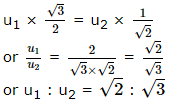
Angles of projection,
θ1 = 30º
θ2 = 45º
Suppose velocities of projection are u1 and u2
Now, at the highest point on the trajectory, the velocity of each ball is horizontal with components,
v1y = 0 = v2y
and v1x = u1 cos θ1
v2x = u2 cos θ2
According to question,
u1 cos θ1 = u2 cos θ2
u1 cos 30º = u2 cos 45º
A conducting sphere of radius 10 cm is charged with 10 μC. Another uncharged sphere of radius 20 cm in allowed to touch it for some time. If both the spheres are separated, then surface density of charges on the spheres will be in the ratio of- a)1:4
- b)4:1
- c)1:2
- d)2:!
Correct answer is option 'D'. Can you explain this answer?
a)
1:4
b)
4:1
c)
1:2
d)
2:!

|
Adit Raj answered |
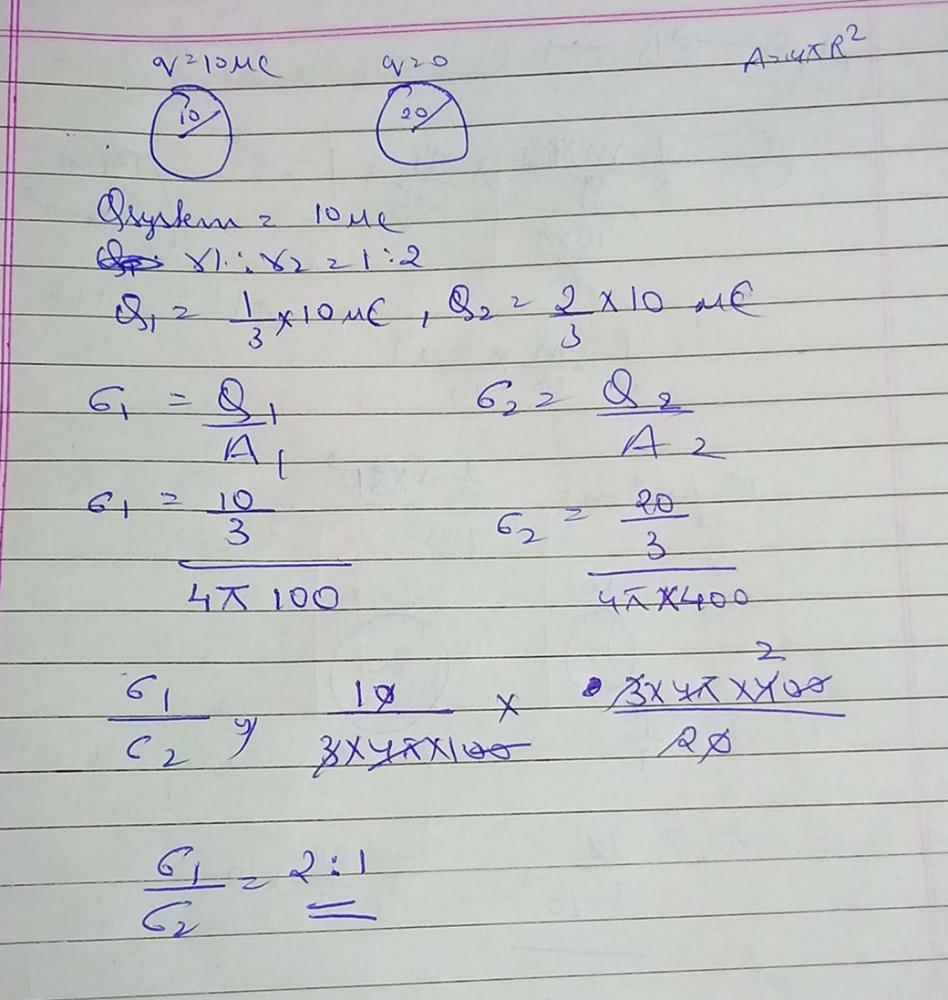
Under the action of a force, a 2 kg body moves such that its position x as a function of time is given by x = t3/3, where x is in meters and t is in sec. The work done by the force in the first two seconds is- a)1600 J
- b)1.0 J
- c)16 J
- d)1.6 J
Correct answer is option 'C'. Can you explain this answer?
Under the action of a force, a 2 kg body moves such that its position x as a function of time is given by x = t3/3, where x is in meters and t is in sec. The work done by the force in the first two seconds is
a)
1600 J
b)
1.0 J
c)
16 J
d)
1.6 J
|
|
Sankar Tiwari answered |
Work Done by a Force
The work done by a force on an object is defined as the product of the force applied on the object and the displacement of the object in the direction of the force. Mathematically, it can be represented as:
Work (W) = Force (F) × Displacement (d) × cos(θ)
where θ is the angle between the force vector and the displacement vector.
In this case, the position of the body as a function of time is given by x = t^3/3, where x is in meters and t is in seconds. To find the work done by the force on the body in the first two seconds, we need to calculate the displacement of the body during this time period.
Calculating Displacement
To calculate the displacement, we need to find the difference in position of the body at the initial and final times. Let's consider the initial time as t = 0 seconds and the final time as t = 2 seconds.
Initial position (x1) at t = 0 seconds:
x1 = (0)^3/3 = 0
Final position (x2) at t = 2 seconds:
x2 = (2)^3/3 = 8/3 meters
Displacement (d) = x2 - x1
= 8/3 - 0
= 8/3 meters
Calculating Work Done
Now that we have the displacement, we can calculate the work done by the force. However, we need to know the force applied on the body, which is not given in the question. Without the force, we cannot accurately determine the work done. Therefore, it is not possible to solve this problem without additional information.
The correct answer cannot be determined based on the information provided.
The work done by a force on an object is defined as the product of the force applied on the object and the displacement of the object in the direction of the force. Mathematically, it can be represented as:
Work (W) = Force (F) × Displacement (d) × cos(θ)
where θ is the angle between the force vector and the displacement vector.
In this case, the position of the body as a function of time is given by x = t^3/3, where x is in meters and t is in seconds. To find the work done by the force on the body in the first two seconds, we need to calculate the displacement of the body during this time period.
Calculating Displacement
To calculate the displacement, we need to find the difference in position of the body at the initial and final times. Let's consider the initial time as t = 0 seconds and the final time as t = 2 seconds.
Initial position (x1) at t = 0 seconds:
x1 = (0)^3/3 = 0
Final position (x2) at t = 2 seconds:
x2 = (2)^3/3 = 8/3 meters
Displacement (d) = x2 - x1
= 8/3 - 0
= 8/3 meters
Calculating Work Done
Now that we have the displacement, we can calculate the work done by the force. However, we need to know the force applied on the body, which is not given in the question. Without the force, we cannot accurately determine the work done. Therefore, it is not possible to solve this problem without additional information.
The correct answer cannot be determined based on the information provided.
The Young's modulus of a wire of length (L) and radius (r) is Y N-m⁻2. If the length is reduced to L/2 and radius to r/2, then Young's modulus for the wire will be- a)Y/2
- b)Y
- c)2 Y
- d)4 Y
Correct answer is option 'B'. Can you explain this answer?
The Young's modulus of a wire of length (L) and radius (r) is Y N-m⁻2. If the length is reduced to L/2 and radius to r/2, then Young's modulus for the wire will be
a)
Y/2
b)
Y
c)
2 Y
d)
4 Y
|
|
Bidyut Das answered |
B
Young's modulus does not depend on the length or radius of the material.
Young's modulus does not depend on the length or radius of the material.
The number of turns in the primary and the secondary turns of a transformer are 1000 and 3000 respectively. If 80 volts A.C. is supplied to the primary coil of the transformer, then the potential difference/turn of the secondary coil would be- a)240 V
- b)2400 V
- c)0.24 V
- d)0.08 V
Correct answer is option 'D'. Can you explain this answer?
The number of turns in the primary and the secondary turns of a transformer are 1000 and 3000 respectively. If 80 volts A.C. is supplied to the primary coil of the transformer, then the potential difference/turn of the secondary coil would be
a)
240 V
b)
2400 V
c)
0.24 V
d)
0.08 V
|
|
Puja Chakraborty answered |
Explanation:
Transformer Formula:
The transformer formula is given as follows:
V1/V2 = N1/N2
Where,
V1 is the primary voltage
V2 is the secondary voltage
N1 is the number of turns in the primary coil
N2 is the number of turns in the secondary coil
Given Data:
N1 = 1000
N2 = 3000
V1 = 80 V
We need to find the potential difference per turn in the secondary coil.
Calculation:
Using the transformer formula,
V1/V2 = N1/N2
80/V2 = 1000/3000
V2 = (80 x 3000)/1000
V2 = 240 V
The potential difference per turn in the secondary coil can be calculated as follows:
Potential difference per turn = V2/N2
Potential difference per turn = 240/3000
Potential difference per turn = 0.08 V
Therefore, the potential difference per turn in the secondary coil would be 0.08 V. Hence, option D is the correct answer.
Transformer Formula:
The transformer formula is given as follows:
V1/V2 = N1/N2
Where,
V1 is the primary voltage
V2 is the secondary voltage
N1 is the number of turns in the primary coil
N2 is the number of turns in the secondary coil
Given Data:
N1 = 1000
N2 = 3000
V1 = 80 V
We need to find the potential difference per turn in the secondary coil.
Calculation:
Using the transformer formula,
V1/V2 = N1/N2
80/V2 = 1000/3000
V2 = (80 x 3000)/1000
V2 = 240 V
The potential difference per turn in the secondary coil can be calculated as follows:
Potential difference per turn = V2/N2
Potential difference per turn = 240/3000
Potential difference per turn = 0.08 V
Therefore, the potential difference per turn in the secondary coil would be 0.08 V. Hence, option D is the correct answer.
In the following question, a Statement of Assertion (A) is given followed by a corresponding Reason (R) just below it. Read the Statements carefully and mark the correct answer-
Assertion(A): For stable equilibrium, Force has to be zero and potential energy should be minimum.
Reason(R): For equilibrium, it is not necessary that the force is not zero.- a)Both Assertion and Reason are true and Reason is the correct explanation of assertion.
- b)Both Assertion and Reason are true and Reason is not the correct explanation of assertion
- c)Assertion is true but Reason is false.
- d)Assertion is false but Reason is true.
Correct answer is option 'C'. Can you explain this answer?
In the following question, a Statement of Assertion (A) is given followed by a corresponding Reason (R) just below it. Read the Statements carefully and mark the correct answer-
Assertion(A): For stable equilibrium, Force has to be zero and potential energy should be minimum.
Reason(R): For equilibrium, it is not necessary that the force is not zero.
Assertion(A): For stable equilibrium, Force has to be zero and potential energy should be minimum.
Reason(R): For equilibrium, it is not necessary that the force is not zero.
a)
Both Assertion and Reason are true and Reason is the correct explanation of assertion.
b)
Both Assertion and Reason are true and Reason is not the correct explanation of assertion
c)
Assertion is true but Reason is false.
d)
Assertion is false but Reason is true.

|
Utkarsh Kulkarni answered |
If there is an external force acting on a body, them it possesses some acceleration, hence it is not in equilibrium due to it's motion.
If the potential energy is not minimum, there will be some interactions between the atoms (or molecules), hence, equilibrium is not present.
If the potential energy is not minimum, there will be some interactions between the atoms (or molecules), hence, equilibrium is not present.
A 2kg ball moving at 24 ms-1 undergoes inelastic head-on collision with a 4 kg ball moving in the opposite direction at 48 ms-1. If the coefficient of restitution is 2/3, their velocities in ms-1 after impact are- a)-56,-8
- b)-28,-4
- c)-14,-2
- d)-7,-1
Correct answer is option 'A'. Can you explain this answer?
A 2kg ball moving at 24 ms-1 undergoes inelastic head-on collision with a 4 kg ball moving in the opposite direction at 48 ms-1. If the coefficient of restitution is 2/3, their velocities in ms-1 after impact are
a)
-56,-8
b)
-28,-4
c)
-14,-2
d)
-7,-1

|
Smrity answered |
Ans is a.
A mercury vapour lamp is the example of- a)line emission spectrum
- b)continuous emission spectrum
- c)band emission spectrum
- d)none of these
Correct answer is option 'A'. Can you explain this answer?
A mercury vapour lamp is the example of
a)
line emission spectrum
b)
continuous emission spectrum
c)
band emission spectrum
d)
none of these

|
Sandy Naaz answered |
Mercury vapor lamps are metal vapor lamps based on light emission from mercury (Hg) atoms.
A ball is projected with kinetic energy E at an angle of 45º to the horizontal. At the highest point during its flight, its kinetic energy will be- a)zero
- b)E/2
- c)2E
- d)E
Correct answer is option 'B'. Can you explain this answer?
A ball is projected with kinetic energy E at an angle of 45º to the horizontal. At the highest point during its flight, its kinetic energy will be
a)
zero
b)
E/2
c)
2E
d)
E
|
|
Akanksha Das answered |
° to the horizontal. Ignoring air resistance, the maximum height the ball reaches is equal to E/g, where g is the acceleration due to gravity (9.8 m/s²). This can be found using the conservation of energy, where the initial kinetic energy is converted into potential energy at the maximum height.
To find the horizontal range of the ball, we can use the formula:
range = (2 * v₀² * sinθ * cosθ) / g
where v₀ is the initial velocity, θ is the angle of projection (45°), and g is the acceleration due to gravity.
Since the initial velocity is related to the kinetic energy by:
E = (1/2) * m * v₀²
where m is the mass of the ball, we can solve for v₀:
v₀ = sqrt(2E/m)
Substituting this into the range formula, we get:
range = (2 * sqrt(2E/m)² * sin45° * cos45°) / g
range = (4E/m * 1/2 * 1/2) / g
range = E/mg
Therefore, the horizontal range of the ball is equal to E/mg.
To find the horizontal range of the ball, we can use the formula:
range = (2 * v₀² * sinθ * cosθ) / g
where v₀ is the initial velocity, θ is the angle of projection (45°), and g is the acceleration due to gravity.
Since the initial velocity is related to the kinetic energy by:
E = (1/2) * m * v₀²
where m is the mass of the ball, we can solve for v₀:
v₀ = sqrt(2E/m)
Substituting this into the range formula, we get:
range = (2 * sqrt(2E/m)² * sin45° * cos45°) / g
range = (4E/m * 1/2 * 1/2) / g
range = E/mg
Therefore, the horizontal range of the ball is equal to E/mg.
Two spherical conductors A and B having equal radii and carrying equal charges on them, repel each other with a force F, when kept apart at some distance. A third spherical conductor C having same radius as that of A, but uncharged, is brought in contact with A, then brought in contact with B and finally removed away from both. The new force of repulsion between the conductors A and B is- a)F/4
- b)F/8
- c)3F/4
- d)3F/8
Correct answer is option 'D'. Can you explain this answer?
Two spherical conductors A and B having equal radii and carrying equal charges on them, repel each other with a force F, when kept apart at some distance. A third spherical conductor C having same radius as that of A, but uncharged, is brought in contact with A, then brought in contact with B and finally removed away from both. The new force of repulsion between the conductors A and B is
a)
F/4
b)
F/8
c)
3F/4
d)
3F/8
|
|
Anwesha Pati answered |
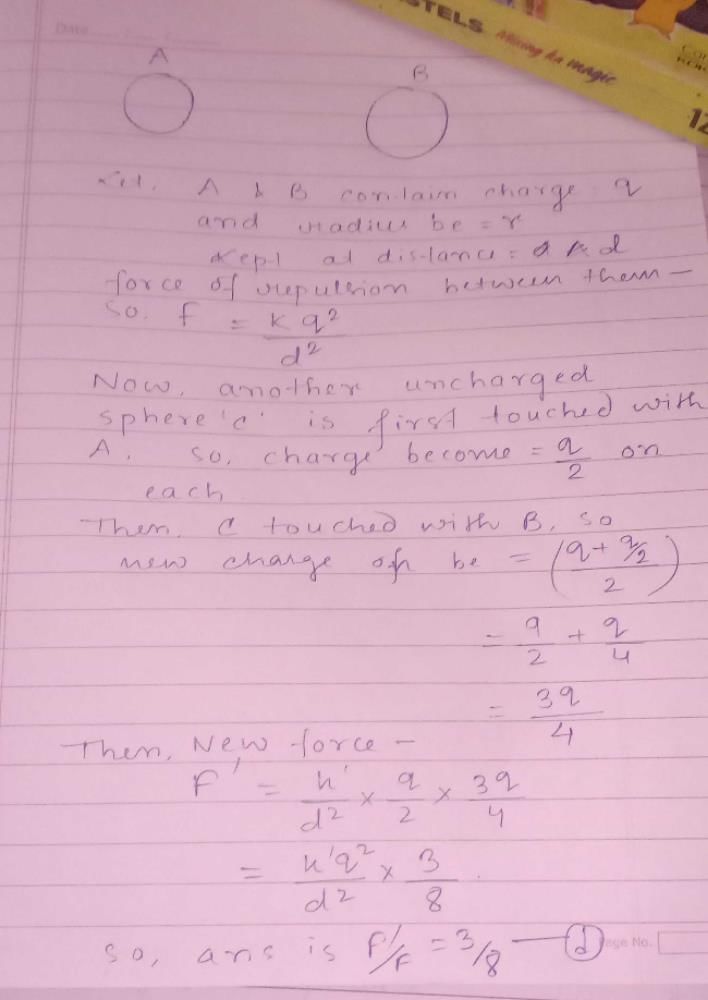
de-Broglie hypothesis treated electrons as- a)Particles
- b)Waves
- c)Both 'a' and 'b'
- d)None of these
Correct answer is 'B'. Can you explain this answer?
a)
Particles
b)
Waves
c)
Both 'a' and 'b'
d)
None of these
|
|
Pooja Mehta answered |
Louis de Broglie proposed that all particles could be treated as matter waves with a wavelength \lambdaλlambda, given by the following equation:
λ = h/mv
The resistance of two bulbs of the same voltage are in the ratio 1:2. On connecting them in parallel the power consumption will be in the ratio- a)1:2
- b)1:1
- c)1:4
- d)2:1
Correct answer is option 'D'. Can you explain this answer?
The resistance of two bulbs of the same voltage are in the ratio 1:2. On connecting them in parallel the power consumption will be in the ratio
a)
1:2
b)
1:1
c)
1:4
d)
2:1
|
|
Deepak Jangid answered |
Voltage ratio=1:2
power consumption ratio=1/1:1/2
=2:1
power consumption ratio=1/1:1/2
=2:1
The temperature of hot and cold end of a 20 cm long rod in thermal steady state are at 100ºC and 20ºC respectively. Temperature at the centre of the rod is- a)50ºC
- b)60ºC
- c)40ºC
- d)30ºC
Correct answer is option 'B'. Can you explain this answer?
The temperature of hot and cold end of a 20 cm long rod in thermal steady state are at 100ºC and 20ºC respectively. Temperature at the centre of the rod is
a)
50ºC
b)
60ºC
c)
40ºC
d)
30ºC
|
|
Nishanth Singh answered |
The temperature of the hot and cold ends of a 20 cm long rod in thermal steady state are at 100 degrees Celsius.
In the following question, a Statement of Assertion (A) is given followed by a corresponding Reason (R) just below it. Read the Statements carefully and mark the correct answer-
Assertion(A): A charged particle undergoes non-rectilinear motion in a constant magnetic field. The only force acting on the particle is the magnetic force. Then kinetic energy of this particle remains constant but momentum of the particle changes.
Reason(R) : A force that always acts on the particle in direction perpendicular to its velocity does no work on the particle. But whenever a force acts on the particle, momentum of the particle changes.- a)Both Assertion and Reason are true and Reason is the correct explanation of Assertion.
- b)Both Assertion and Reason are true and Reason is not the correct explanation of Assertion.
- c)Assertion is true but Reason is false.
- d)Assertion is false but Reason is true.
Correct answer is option 'B'. Can you explain this answer?
In the following question, a Statement of Assertion (A) is given followed by a corresponding Reason (R) just below it. Read the Statements carefully and mark the correct answer-
Assertion(A): A charged particle undergoes non-rectilinear motion in a constant magnetic field. The only force acting on the particle is the magnetic force. Then kinetic energy of this particle remains constant but momentum of the particle changes.
Reason(R) : A force that always acts on the particle in direction perpendicular to its velocity does no work on the particle. But whenever a force acts on the particle, momentum of the particle changes.
Assertion(A): A charged particle undergoes non-rectilinear motion in a constant magnetic field. The only force acting on the particle is the magnetic force. Then kinetic energy of this particle remains constant but momentum of the particle changes.
Reason(R) : A force that always acts on the particle in direction perpendicular to its velocity does no work on the particle. But whenever a force acts on the particle, momentum of the particle changes.
a)
Both Assertion and Reason are true and Reason is the correct explanation of Assertion.
b)
Both Assertion and Reason are true and Reason is not the correct explanation of Assertion.
c)
Assertion is true but Reason is false.
d)
Assertion is false but Reason is true.
|
|
Stuti Sen answered |
Explanation:
Assertion and Reason Analysis:
- The assertion states that a charged particle undergoes non-rectilinear motion in a constant magnetic field with the only force acting on it being the magnetic force.
- The reason given explains that a force acting perpendicular to the particle's velocity does not work on the particle but changes its momentum.
Correct Interpretation:
- Both the assertion and reason are true in this scenario.
- The reason provided is valid but does not fully explain why the kinetic energy remains constant while the momentum changes.
- The magnetic force does not do work on the particle, so the kinetic energy remains constant. However, the change in momentum is due to the force changing the direction of motion of the charged particle.
Conclusion:
- Therefore, option B is the correct choice where both the assertion and reason are true, but the reason is not a complete explanation for the assertion.
Assertion and Reason Analysis:
- The assertion states that a charged particle undergoes non-rectilinear motion in a constant magnetic field with the only force acting on it being the magnetic force.
- The reason given explains that a force acting perpendicular to the particle's velocity does not work on the particle but changes its momentum.
Correct Interpretation:
- Both the assertion and reason are true in this scenario.
- The reason provided is valid but does not fully explain why the kinetic energy remains constant while the momentum changes.
- The magnetic force does not do work on the particle, so the kinetic energy remains constant. However, the change in momentum is due to the force changing the direction of motion of the charged particle.
Conclusion:
- Therefore, option B is the correct choice where both the assertion and reason are true, but the reason is not a complete explanation for the assertion.
The north pole of a long horizontal bar magnet is being brought closer to a vertical conducting plane, along the perpendicular direction. The induced current in the conducting plane is- a)Clockwise
- b)Anticlockwise
- c)Horizonatal
- d)Vertical
Correct answer is option 'B'. Can you explain this answer?
The north pole of a long horizontal bar magnet is being brought closer to a vertical conducting plane, along the perpendicular direction. The induced current in the conducting plane is
a)
Clockwise
b)
Anticlockwise
c)
Horizonatal
d)
Vertical

|
Mrinalini Bajaj answered |
The induced emf will oppose the motion of the magnet. Applying the right-hand rule, the direction of induced current will be clockwise.
Above image shows the direction of the magnetic force acting on a charged particle. The force on a positively charged particle with velocity v and making an angle θ with the magnetic field B is given by the right-hand rule.
A body of mass 5 kg explodes at rest into three fragments with masses in the ratio 1 : 1 : 3. The fragements with equal masses fly in mutually perpendicular directions with speeds of 21 m/sec. The velocity of the heaviest fragment will be- a)11.5 m/sec
- b)14.0 m/sec
- c)7.0 m/sec
- d)9.87 m/sec
Correct answer is option 'D'. Can you explain this answer?
A body of mass 5 kg explodes at rest into three fragments with masses in the ratio 1 : 1 : 3. The fragements with equal masses fly in mutually perpendicular directions with speeds of 21 m/sec. The velocity of the heaviest fragment will be
a)
11.5 m/sec
b)
14.0 m/sec
c)
7.0 m/sec
d)
9.87 m/sec

|
Ishani Nambiar answered |
Momentum of first body
p1 = 1 x 21 = 21 kg-m / sec.
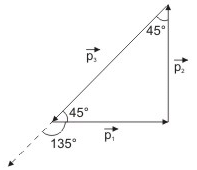
Momentum of second body
p2 = 1 x 21 = 21 kg. m / sec.
Momentum of third body p3 = 3V kg - m / sec
Initial momentum = zero
∴ final momentum = 0

p1 = 1 x 21 = 21 kg-m / sec.
Momentum of second body
p2 = 1 x 21 = 21 kg. m / sec.
Momentum of third body p3 = 3V kg - m / sec
Initial momentum = zero
∴ final momentum = 0
A motor having an armature of resistance 2Ω is designed to operate at 220 V mains. At full speed, it develops a back e.m.f. of 210V. When the motor is running at full speed, the current in the armature is- a)5 A
- b)105 A
- c)110 A
- d)215 A
Correct answer is option 'A'. Can you explain this answer?
A motor having an armature of resistance 2Ω is designed to operate at 220 V mains. At full speed, it develops a back e.m.f. of 210V. When the motor is running at full speed, the current in the armature is
a)
5 A
b)
105 A
c)
110 A
d)
215 A
|
|
Keerthana Chopra answered |
Given:
Armature resistance (Ra) = 2 ohm
Applied voltage (V) = 220 V
Back e.m.f. (Eb) = 210 V
To calculate: Current in the armature at full speed
Solution:
1. Calculate the net voltage across the armature:
Net voltage (Vnet) = V - Eb
= 220 V - 210 V
= 10 V
2. Calculate the current in the armature using Ohm's law:
Ia = Vnet / Ra
= 10 V / 2 ohm
= 5 A
Therefore, the current in the armature at full speed is 5 A.
Conclusion:
The correct answer is option A, i.e., 5 A.
Armature resistance (Ra) = 2 ohm
Applied voltage (V) = 220 V
Back e.m.f. (Eb) = 210 V
To calculate: Current in the armature at full speed
Solution:
1. Calculate the net voltage across the armature:
Net voltage (Vnet) = V - Eb
= 220 V - 210 V
= 10 V
2. Calculate the current in the armature using Ohm's law:
Ia = Vnet / Ra
= 10 V / 2 ohm
= 5 A
Therefore, the current in the armature at full speed is 5 A.
Conclusion:
The correct answer is option A, i.e., 5 A.
In the following question, a Statement of Assertion (A) is given followed by a corresponding Reason (R) just below it. Read the Statements carefully and mark the correct answer-
Assertion(A): A particle move from A (X1,Y1,Z1) to B (X2,Y2,Z2), displacement is given as (X2-X1)i, (Y2-Y1)j, (Z2-Z1)k.
Reason (R):Displacement can be positive, negative or zero.- a)Both Assertion and Reason are true and Reason is the correct explanation of assertion.
- b)Both Assertion and Reason are true and Reason is not the correct explanation of assertion
- c)Assertion is true but Reason is false.
- d)Assertion is false but Reason is true.
Correct answer is option 'B'. Can you explain this answer?
In the following question, a Statement of Assertion (A) is given followed by a corresponding Reason (R) just below it. Read the Statements carefully and mark the correct answer-
Assertion(A): A particle move from A (X1,Y1,Z1) to B (X2,Y2,Z2), displacement is given as (X2-X1)i, (Y2-Y1)j, (Z2-Z1)k.
Reason (R):Displacement can be positive, negative or zero.
Assertion(A): A particle move from A (X1,Y1,Z1) to B (X2,Y2,Z2), displacement is given as (X2-X1)i, (Y2-Y1)j, (Z2-Z1)k.
Reason (R):Displacement can be positive, negative or zero.
a)
Both Assertion and Reason are true and Reason is the correct explanation of assertion.
b)
Both Assertion and Reason are true and Reason is not the correct explanation of assertion
c)
Assertion is true but Reason is false.
d)
Assertion is false but Reason is true.
|
|
Priya Datta answered |
Answer:
Explanation:
Assertion: A particle move from A (X1,Y1,Z1) to B (X2,Y2,Z2), displacement is given as (X2-X1)i, (Y2-Y1)j, (Z2-Z1)k.
Reason: Displacement can be positive, negative or zero.
Explanation:
- The Assertion is true as the displacement of a particle can be calculated by subtracting initial position from the final position. So, the displacement of the particle from A to B is given as (X2-X1)i, (Y2-Y1)j, (Z2-Z1)k.
- The Reason is also true as the displacement can be positive, negative or zero. If the final position is ahead of the initial position, then displacement is positive. If the final position is behind the initial position, then displacement is negative. And, if both the positions are the same, then the displacement is zero.
- However, the Reason does not explain the Assertion completely. It only provides additional information about displacement and does not clarify how the displacement of the particle is calculated.
- Therefore, the correct answer is option 'B' i.e. Both Assertion and Reason are true and Reason is not the correct explanation of the assertion.
In Young's double slit interference experiment the wavelength of light used is 6000 Å . If the path difference between waves reaching a point P on the screen is 1.5 microns, then at that point P- a)Second bright band occurs
- b)Second dark band occurs
- c)Third dark band occurs
- d)Third bright band occurs
Correct answer is option 'C'. Can you explain this answer?
In Young's double slit interference experiment the wavelength of light used is 6000 Å . If the path difference between waves reaching a point P on the screen is 1.5 microns, then at that point P
a)
Second bright band occurs
b)
Second dark band occurs
c)
Third dark band occurs
d)
Third bright band occurs
|
|
Pankaj Datta answered |
To understand why the third dark band occurs at point P in Young's double slit interference experiment, let's first go over the basics of the experiment and the conditions for bright and dark bands.
1. Young's Double Slit Experiment:
In Young's double slit interference experiment, a beam of light passes through two narrow slits and forms an interference pattern on a screen placed behind the slits. This pattern is a result of the superposition of two coherent waves generated by the slits.
2. Conditions for Bright and Dark Bands:
The interference pattern consists of alternating bright and dark bands. The bright bands occur where the waves are in phase and undergo constructive interference, resulting in a bright region on the screen. The dark bands occur where the waves are out of phase and undergo destructive interference, resulting in a dark region on the screen.
3. Path Difference:
Path difference is the difference in the distances traveled by the two waves from the two slits to a specific point on the screen. It determines whether constructive or destructive interference occurs at that point.
4. Relationship between Path Difference and Bright/Dark Bands:
The path difference between the two waves determines the order of the bright and dark bands. For constructive interference (bright bands), the path difference should be an integer multiple of the wavelength (λ) of the light used. For destructive interference (dark bands), the path difference should be a half-integer multiple of the wavelength.
Now, let's apply these concepts to the given scenario:
- The wavelength of the light used is 6000 Å (angstroms), which is equivalent to 6000 x 10^-10 meters or 6000 x 10^-7 microns.
- The path difference between the waves reaching point P on the screen is 1.5 microns, which is 1.5 x 10^-6 meters or 1.5 x 10^-3 microns.
To determine whether a bright or dark band occurs at point P, we need to compare the path difference with the wavelength:
- For constructive interference (bright bands), the path difference should be an integer multiple of the wavelength. In this case, 1.5 microns is not an integer multiple of 6000 Å, so a bright band does not occur.
- For destructive interference (dark bands), the path difference should be a half-integer multiple of the wavelength. In this case, 1.5 microns is equal to 1.5 x 10^-3 microns, which is half of 3 x 10^-3 microns (which is 6000 Å). Therefore, a dark band occurs at point P.
Hence, the correct answer is option 'C' - Third dark band occurs.
1. Young's Double Slit Experiment:
In Young's double slit interference experiment, a beam of light passes through two narrow slits and forms an interference pattern on a screen placed behind the slits. This pattern is a result of the superposition of two coherent waves generated by the slits.
2. Conditions for Bright and Dark Bands:
The interference pattern consists of alternating bright and dark bands. The bright bands occur where the waves are in phase and undergo constructive interference, resulting in a bright region on the screen. The dark bands occur where the waves are out of phase and undergo destructive interference, resulting in a dark region on the screen.
3. Path Difference:
Path difference is the difference in the distances traveled by the two waves from the two slits to a specific point on the screen. It determines whether constructive or destructive interference occurs at that point.
4. Relationship between Path Difference and Bright/Dark Bands:
The path difference between the two waves determines the order of the bright and dark bands. For constructive interference (bright bands), the path difference should be an integer multiple of the wavelength (λ) of the light used. For destructive interference (dark bands), the path difference should be a half-integer multiple of the wavelength.
Now, let's apply these concepts to the given scenario:
- The wavelength of the light used is 6000 Å (angstroms), which is equivalent to 6000 x 10^-10 meters or 6000 x 10^-7 microns.
- The path difference between the waves reaching point P on the screen is 1.5 microns, which is 1.5 x 10^-6 meters or 1.5 x 10^-3 microns.
To determine whether a bright or dark band occurs at point P, we need to compare the path difference with the wavelength:
- For constructive interference (bright bands), the path difference should be an integer multiple of the wavelength. In this case, 1.5 microns is not an integer multiple of 6000 Å, so a bright band does not occur.
- For destructive interference (dark bands), the path difference should be a half-integer multiple of the wavelength. In this case, 1.5 microns is equal to 1.5 x 10^-3 microns, which is half of 3 x 10^-3 microns (which is 6000 Å). Therefore, a dark band occurs at point P.
Hence, the correct answer is option 'C' - Third dark band occurs.
The ratio of secondary to the primary turns in a transformer is 3 : 2. If the power output be P, then the input power, neglecting all losses, must be equal to- a)5 P
- b)1.5 P
- c)2/ 5 P
- d)P
Correct answer is option 'D'. Can you explain this answer?
The ratio of secondary to the primary turns in a transformer is 3 : 2. If the power output be P, then the input power, neglecting all losses, must be equal to
a)
5 P
b)
1.5 P
c)
2/ 5 P
d)
P
|
|
Srestha Patel answered |
Given information:
Ratio of secondary to primary turns = 3:2
To find:
Input power
Solution:
Let the primary turns be x and the secondary turns be y.
Given, y/x = 3/2
Therefore, x = (2/3)y
Power output, P = Power input
Power output can be given as P = V2I2, where V2 and I2 are the voltage and current in the secondary coil.
Since V2/V1 = N2/N1 = 3/2, we can say that V2 = (3/2)V1
Also, I1/I2 = N2/N1 = 3/2, we can say that I1 = (2/3)I2
Substituting V2 and I1 in the expression for power output, P = V2I2, we get:
P = (3/2)V1(2/3)I2
P = V1I2
Power input is equal to power output only when there are no losses in the transformer.
Therefore, the input power, neglecting all losses, is equal to P.
Hence, the correct option is D.
Ratio of secondary to primary turns = 3:2
To find:
Input power
Solution:
Let the primary turns be x and the secondary turns be y.
Given, y/x = 3/2
Therefore, x = (2/3)y
Power output, P = Power input
Power output can be given as P = V2I2, where V2 and I2 are the voltage and current in the secondary coil.
Since V2/V1 = N2/N1 = 3/2, we can say that V2 = (3/2)V1
Also, I1/I2 = N2/N1 = 3/2, we can say that I1 = (2/3)I2
Substituting V2 and I1 in the expression for power output, P = V2I2, we get:
P = (3/2)V1(2/3)I2
P = V1I2
Power input is equal to power output only when there are no losses in the transformer.
Therefore, the input power, neglecting all losses, is equal to P.
Hence, the correct option is D.
In the following question, a Statement of Assertion (A) is given followed by a corresponding Reason (R) just below it. Read the Statements carefully and mark the correct answer-
Assertion(A): Everybody will have natural tendency to remain at rest.
Reason(R): Force always acts in the direction of motion.- a)Both Assertion and Reason are true and Reason is the correct explanation of assertion.
- b)Both Assertion and Reason are true and Reason is not the correct explanation of assertion
- c)Assertion is true but Reason is false.
- d)Assertion is false but Reason is true.
Correct answer is option 'C'. Can you explain this answer?
In the following question, a Statement of Assertion (A) is given followed by a corresponding Reason (R) just below it. Read the Statements carefully and mark the correct answer-
Assertion(A): Everybody will have natural tendency to remain at rest.
Reason(R): Force always acts in the direction of motion.
Assertion(A): Everybody will have natural tendency to remain at rest.
Reason(R): Force always acts in the direction of motion.
a)
Both Assertion and Reason are true and Reason is the correct explanation of assertion.
b)
Both Assertion and Reason are true and Reason is not the correct explanation of assertion
c)
Assertion is true but Reason is false.
d)
Assertion is false but Reason is true.
|
|
Suresh Kumar answered |
From newtons 1st law we know that..;a body at rest ..will remain at rest until unless any external force acts on it...so assertion is true
In case of friction it acts opposite to the direction of motion...so reason is wrong over here...
hence..option c is correct.
In case of friction it acts opposite to the direction of motion...so reason is wrong over here...
hence..option c is correct.
Chapter doubts & questions for AIIMS Physics Mock Tests - AIIMS Mock Tests & Previous Year Question Papers 2025 is part of NEET exam preparation. The chapters have been prepared according to the NEET exam syllabus. The Chapter doubts & questions, notes, tests & MCQs are made for NEET 2025 Exam. Find important definitions, questions, notes, meanings, examples, exercises, MCQs and online tests here.
Chapter doubts & questions of AIIMS Physics Mock Tests - AIIMS Mock Tests & Previous Year Question Papers in English & Hindi are available as part of NEET exam.
Download more important topics, notes, lectures and mock test series for NEET Exam by signing up for free.

Contact Support
Our team is online on weekdays between 10 AM - 7 PM
Typical reply within 3 hours
|
Free Exam Preparation
at your Fingertips!
Access Free Study Material - Test Series, Structured Courses, Free Videos & Study Notes and Prepare for Your Exam With Ease

 Join the 10M+ students on EduRev
Join the 10M+ students on EduRev
|

|
Create your account for free
OR
Forgot Password
OR
Signup on EduRev and stay on top of your study goals
10M+ students crushing their study goals daily

